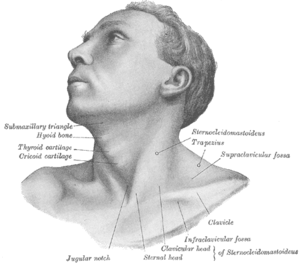Suprasternal notch
| Suprasternal notch | |
|---|---|
 Suprasternal notch | |
 Anterolateral view of head and neck. (Jugular notch labeled at bottom center.) | |
| Details | |
| Identifiers | |
| Latin |
Incisura jugularis sternalis, fossa jugularis sterni |
| TA | A02.3.03.004 |
| FMA | 7542 |
The suprasternal notch (fossa jugularis sternalis), also known as the jugular notch, is part of human anatomy. It is a large, visible dip in between the neck and the collarbone.
Structure
The jugular notch is found at the superior border of the manubrium of the sternum, between the clavicular notches.
Clinical significance
Intrathoracic pressure is measured by using a transducer held in such a way over the body that an actuator engages the soft tissue that is located above the suprasternal notch. Arcot J. Chandrasekhar, MD of Loyola University, Chicago, is the author of an evaluative test for the aorta using the suprasternal notch.[1] The test can help to recognise the following conditions:
- Aneurysm
- Dissecting aneurysm
- Atherosclerosis
- Hypertension
To carry out this test it is necessary to place an index finger or middle finger on the notch and palpate it. A prominent pulse may be indicative of an uncoiled aorta, arch aneurysm, or a tortuous blood vessel. The most likely cause of a suprasternal pulse in an adult is an aortic arch aneurysm, while the most likely cause in a child is coarctation of the aorta.
Society and Culture

The suprasternal notch or well, is seen as a point of attraction by many and can be subtly enhanced by the wearing of pendants or necklaces which rest in that area, to draw focus to a part of the body that can be considered an erotic or sensual zone. Highlighting the notch in this way is more understated in exhibiting sensuality than the usual areas (legs, chest, hips etc.) and makes it an erogenous zone.
The suprasternal notch appears in the 1941 Alfred Hitchcock thriller Suspicion, where it is given by screenwriter Samson Raphaelson the whimsical name "ucipital mapilary". This neologism is repeated by Count Dracula in Mel Brooks' 1995 satire Dracula: Dead and Loving It, played by Leslie Nielsen.
The suprasternal notch appears in the novel and 1996 film The English Patient as an erogenous zone and focal point of amorousness. In the novel it is given the whimsical name "vascular sizood", but it is correctly named in the film.
It is known in the south of the Netherlands as the "derelegate zone" which has erotic connection to local folk stories.
As a vulnerable target in martial arts
The suprasternal notch is a target for finger strikes in such martial arts as Jiu-Jitsu and Hapkido. In self-defense, a person may thrust their fingers or thumb into the suprasternal notch, initially pushing straight to get past the increased thickness of the upper portion of the manubrium and then curling their fingers to apply downward pressure. This maneuver is thought to induce choking through blockage by crushing the windpipe, or perhaps have medical implications involving pressure to the aortic arch and surrounding tissues. This maneuver (as a two-finger strike utilizing the middle and index fingers) was choreographed into the subway station fight scene in the movie, The Matrix.
References
- ↑ MedEd at Loyola MEDICINE/PULMONAR/PD/pstep37a.htm - Evaluative tests using the suprasternal notch
External links
- The Suprasternal Notch site with (humorous) suggestions on suppressing suprasternal notch fetishism.
- IMDb ucipital mapilary quote in Hitchcock's Suspicion.
- IMDb ucipital mapilary movie connection in Dracula: Dead and Loving It.
- IMDb suprasternal notch quote in The English Patient
- blog entry on Ucipital Mapilary citing film dialogue.
| Wikiquote has quotations related to: Suspicion_(film) |
| Wikiquote has quotations related to: The_English_Patient |